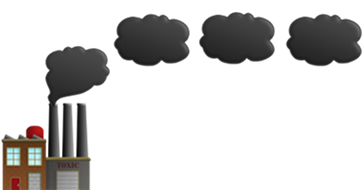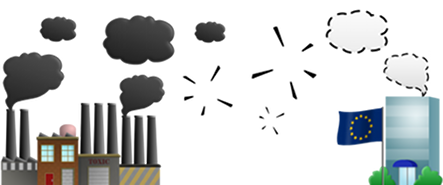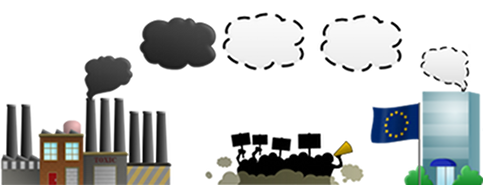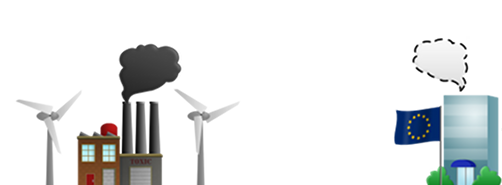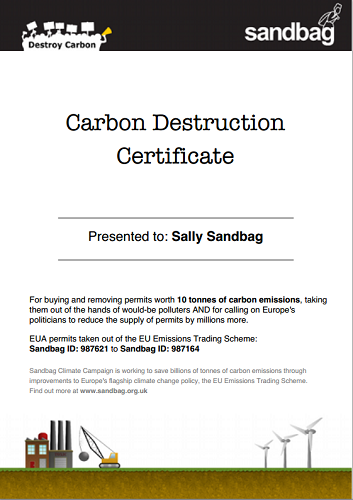How does trading in pollution work?
Carbon dioxide and other greenhouse gases are being emitted in huge volumes all over the planet and are highly
concentrated in rich countries. These additions to the atmosphere last for many years, accumulating and trapping
more of the suns energy. Thankfully some sensible people in the UN and Brussels have decided to take control of the
situation. Rich countries and large commercial sources of greenhouse gases are now legally prevented from emitting
more than a fixed amount in a given year – their emissions are capped. But because it doesn’t really matter to
planet earth where emissions of greenhouse gases occur – they all eventually do the same thing: heat the planet up –
the regulators have said if you have to emit more than your cap, you can, but you have to find someone else who is
prepared to emit less than their cap to sell you their permit to emit. And this market in buying and selling
pollution permits is now underway, governed by rules set periodically by the UN and Europe.
What is the rationale for individuals buying permits and taking them out of the market?
By buying a permit for one tonne of emissions and taking it out of a market we take it out of the hands of would-be
polluters and force them to invest more in cleaning up their act. The market contains many millions of permits so
each individual action has only a small effect but it does genuinely mean one less tonne of permitted emissions. If
lots of us buy permits, however, it will become more expensive to pollute and then cleaner ways of doing things will
receive more investment.
By destroying a permit you are also making yourself a stakeholder in this important issue showing decision makers
that you are prepared to pay now to help solve the problem. Since solving climate change is all about time and money
this is an important action.
Traded markets in pollution rights can be hugely important forces for change if they are designed and implemented
correctly. Produce a low number of permits and the world emits less and the cost of permits rise. Produce too many
and nobody has to do anything and prices fall to zero. Pollution markets are created by Governments. They come under
pressure from emitters to keep the number of permits generous. They also worry about higher prices pushing up the
cost of living. This makes them very, very cautious. By applying pressure in the other direction – by showing we are
prepared to pay for fewer permits to be in circulation we can help to ensure trading really delivers change at the
scale and pace necessary to tackle this problem.
Who’s behind all this and are they making any money out of it?
Sandbag is a not for profit enterprise. We are funded by charitable foundation and the donations of our supporters.
We started Sandbag because we wanted to speed up action being taken to tackle climate change. We also thought some
of the other actions people were being offered to make a difference were not clearly reducing carbon emissions, or
failed to take into account the larger picture of how individuals are affected by and can affect policies like
Europe’s Emissions Trading Scheme. So we aim to be as transparent as possible.
Why the name Sandbag?
We came up with the name Sandbag because for us it symbolised a positive action people could take to protect
themselves from natural disasters and flooding is likely to be increasing impact of global climate change. We also
wanted a single word that would distinguish us from the many ‘climate this’ or ‘carbon thats’ there are already out
there.
Only after we had launched, someone pointed out that sandbags are used as a safety control in hot air ballooning –
‘hot air’ is a term used in emissions trading to describe the permits that become spare through no actually effort
on the behalf of the owner – ie they were given them wrongly in the first place. We like this. Sandbag is all about
controlling ‘hot air’ in emissions trading.
How many should I buy?
You could relate your decision to your own ‘carbon footprint’. We recommend you use the Government’s calculator
available here. Or if you want to track things in a little more detail you can create your own Carbon Account. If
you are interested in not just what you emit directly but also emissions from the things you buy and consume then
you can use WWF’s calculator. This gives a far higher value.
As a rough guide each household in the UK emits about 4-5 tonnes per year. Emissions from transport can add an extra
couple of tonnes and each long haul flight adds another tonne. Adding emissions from the things we consume roughly
doubles your score.
Can I buy a tonne for someone else as a gift?
Yes it is possible to buy tonnes for other people. Just use the Carbon Destruction page and check the ‘Gift’ option.
How much does it cost?
Previously Sandbag charged £25 per tonne. This covered the cost of the permit and included a donation to
support our work. Following feedback from our supporters we now offer carbon permits on a ‘cost plus’ basis. The
price of buying a permit from the market fluctuates with supply and demand in the market. The price we charge
reflects the market price of the permits at the time we purchased them plus a little extra to cover administration
costs. There is option to include a donation on top of this.
Current price: £8.25 per permit/tonne destroyed.
What if I just want to make a donation and not buy permits?
If you would just like to support our research and campaigning work you can make a donation without having tonnes
cancelled in your name. Go to one of our map pages and click the Donate button, or (if you’re a millionaire) contact
us directly. Thanks.
Where does my money go?
If you’re buying permits through our Destroy Carbon service you’re paying for the cost of the permits plus a little
extra to cover our administration.
We earn no revenue for the sales. The current permits available to cancel were purchased
from Vertis.
Donations to Sandbag help to fund our campaigning work.
How do I know a permit has really been cancelled on my behalf?
Each emissions permit that is created has a unique identification number and permits are kept in secure databases
known as registries. Participants hold accounts within the database and exchange certificates when they trade.
Sandbag is a registry account holder the permits that we cancel will all appear in our account. When you join
Sandbag and we cancel permits on your behalf you will receive an electronic certificate with a unique number for
each permit that has been destroyed. We will also periodically publish on this website copies of the registry
account in which all our cancelled allowances are kept and cancelled so you can see exactly what is going on.
Do I have to give money to massive polluting companies?
Yes and no. Emissions trading is founded on the idea that you can harness market forces to deliver an environmental
good. Markets are based on exchanges of goods, so unfortunately, under these rules if we want someone to stop doing
something, we pay. It’s actually not such a bad idea. Most of us have and use money to meet our needs. I need a
stable climate and think we are currently taking too many risks with it so I’m prepared to pay to make a difference.
And these huge polluting companies are actually just making stuff that we need, ok and some stuff we perhaps don’t,
but on the whole they are not James Bond villains deliberately destroying the planet. They only stop doing things if
they’re told to by Governments or if doing so makes them money. Emissions trading is a way of doing both of these
things – Government gives them fewer permits than they need and we go a bit further by paying them to reduce even
more.
I’m already paying for the effect of the emissions trading market in my energy bills – why should I do more?
It is true that because all electricity generators are included in the EU emissions trading scheme, and have been
given fewer allowances than they need, you are already paying for them to reduce emissions, through your electricity
bill. In fact, it’s worth bearing in mind that if you do decide to reduce your own carbon emissions, and you take
actions that reduce your electricity consumption, like fitting low energy light bulbs (or hopefully soon LEDs) then
unless you buy up the corresponding amount of permits from the market you are either just helping the power
companies buy fewer permits or enabling them to sell spare permits to someone else.
This is why Sandbag is so important.
Once the market is established and the permits handed out, the only way to make sure some of your actions count is
to buy up and destroy those permits. We then have a stronger argument the next time caps are being set that there
should be fewer created.
How ‘leaky’ is the emissions trading scheme? How do I know what I’m buying is really making a difference?
In an emissions trading market with a cap, enforcement is a key issue – the European emissions trading scheme is a
legal instrument that is regulated and enforced by environmental regulators in each of the 27 EU countries. Official
registries exist to ensure permits are uniquely identifiable and cannot be counterfeited or double counted.
The EU scheme also allows credits from developing countries to be used up to a certain limit. These credits are
verified and regulated by the UN. When we cancel permits two things can happen – if the limit on use of overseas
credits has not been reached, a credit can be purchased from these approved projects. This creates additional demand
meaning increased reductions in emissions in developing countries. Or, if the limit has been reached, emissions must
be reduced in the EU. Either way the act of cancelling a credit reduces the amount of pollution that would have
occurred otherwise.
How are permits created? If they are handed out for free why should I pay for them?
Permits have until now been handed out free of charge. This approach was taken to give companies time to adjust to
the imposition of limits on something they had until now been able to do freely. It may seem crazy but that’s how
it’s been organised to date. We believe this is the wrong approach and fortunately from 2013 on a large number of
European polluters will have to pay up front for permits to pollute.
We believe the vast majority of polluters should have to pay. Governments can and should use the money received to
support the development of cleaner technologies and to help people who are most vulnerable to increases in energy
prices as limits on pollution get tighter and companies have to pay to adjust.
We don’t want to pay for permits if we don’t have to. That’s why we campaign to ensure far fewer permits are handed
out in the next trading period which is set to begin in 2013. Decisions about how it will work will be being made in
the coming years.
Politicians should have handed out fewer allowances in the first place – why should I pay to make up for their
mistakes?
It is true politicians have made mistakes and they will continue to do so unless they feel pressure from public
opinion and voters. The reason why they handed out too many allowances initially was because they were under
pressure from industry who claimed that if they received too few allowances they would loose out against competitors
in other European countries and the rest of the world.
Sadly that argument won the day and is still being used to slow down action even now. Sandbag doesn’t want your
money to let politicians off the hook – quite the opposite – every supporter who pays to cancel a permit also sends
makes a statement that there should be few permits. That’s why for everyone who destroys carbon through Sandbag a
message is emailed to the EU demanding action to repair the Emissions Trading Scheme.
Sandbag is campaigning to make sure the same mistakes are not made again and to minimise the damage resulting from
decisions made to date that can’t be reversed. Not to do so would be cutting our nose off to spite our face. We can
make a difference despite what the politicians so far have done and we believe we should.
Why won’t Governments just hand out more permits to compensate for the ones we’ve bought up?
Because they can’t and because we’ll be watching. No more credits can be created from now until 2013.
It is entirely legitimate to buy up and destroy permits – nobody has to sell them to us and they will only do so if
they are offered a price they will accept.
Governments cannot explicitly compensate companies for the credits that have been purchased and cancelled out of the
market by individuals. They may want to try, but the rules don’t allow it. And even from 2013 when a new set of
rules and a new batch of permits will be created they won’t be able to. Caps will be set by Europe and not by
individual Member States and it was the EU who made sure individuals could get involved in the market in the first
place.
Will Sandbag cancel other forms of emissions permits or credits or just use EU permits?
The carbon market is primarily a tool for western rich countries who have targets under Kyoto to meet those targets.
There are emissions trading schemes already in operation New Zealand and part of the USA and Australia [see our
world map] but the EU emissions trading scheme is the largest by a long way So that less developed countries can
receive funding for projects that reduce emissions in their countries, the rules allow them to generate and sell
allowances into the market. These allowances are called Certified Emissions Reductions (CERs) and can only be
released after the UN has approved the emissions saving projects they come from.
Sandbag only purchases EU allowances (EUAs) because these are the most easy to track, from the largest and most
important emissions trading scheme and we want to make a point about the need to hand out fewer in the first place.
Does this relate to the Kyoto Protocol in any way?
Sandbag is currently focusing on the EU emissions trading scheme, but this is actually just a tool for the EU to
meet its target under the Kyoto Protocol. The Kyoto Protocol set out to reduce developed countries emissions by 5%
compared to 1990 levels. It too issues permits (known as AAUs) up to the level of a cap and allows trading between
countries that have caps. The allowances created under the EU scheme count towards Kyoto targets too, so each
certificate we buy from the EU scheme also helps the EU meet its target under Kyoto.

